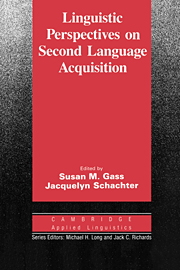III - SEMANTICS/PRAGMATICS
Published online by Cambridge University Press: 05 October 2012
Summary
The chapters in this section are concerned with the multiplicity of factors involved in learning second language word order, particularly the influence of semantics and pragmatics. Languages of the world differ not only in their word order (or more appropriately, constituent order) but also in the strictness of word order. A further differentiating factor among the world's languages is variation among what is known as basic word order, or the predominant order of the primes of subject (S), object (O), and verb (V), if, in fact, a predominant order can even be discerned. Of central relevance to the chapters in this section is what determines interlanguage word order (Rutherford) and what determines the interpretation of word order (Gass).
English is a language with fixed word order: Subject-verb-object (SVO). Sentences such as Mary loves John are grammatical, whereas a sentence such as *Mary John loves is not. On the other hand, there are some languages that have a pragmatically determined word order as opposed to a fixed one. In those languages, word order is determined not by the constraints of the language per se but by the context in which the language is spoken. In Italian, for example, the following sentences are all possible (with variation in intonational and stress patterns):
1. II lupo ha mangiato il topo.
The wolf has eaten the mouse.
2. II topo il lupo (1') ha mangiato.
the mouse the wolf (it-object) has eaten
3. II topo ha mangiato il lupo.
the mouse has eaten the wolf
- Type
- Chapter
- Information
- Linguistic Perspectives on Second Language Acquisition , pp. 159 - 162Publisher: Cambridge University PressPrint publication year: 1989



